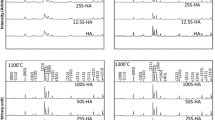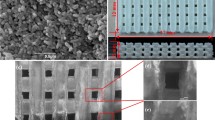Abstract
Freeze casting technique is a simple and effective method for the fabrication of porous ceramic structures. The objective of this work is to study the production and characterization of hydroxyapatite/nanosilica (HA/nSiO2) scaffolds fabricated through this method. In the experimental procedure, the solidified samples were prepared by slurries containing different concentration of HA and nSiO2 followed by sintering procedure at 1200 and 1350 °C. The phase composition, microstructure, and compressive strength of the scaffolds were characterized by X-ray diffraction, scanning electron microscopy, and mechanical strength test. It was found that the porosity of the scaffolds was in the range of 30–86.5 % and the value of compressive strengths lied between 0.16 and 71.96 MPa which were influenced by nSiO2 content, cooling rate, and sintering temperature. With respect to porosity, pore size, and compressive strength, the scaffolds with 5 % nSiO2, the cooling rate of 1 °C/min and the sintering temperature of 1350 °C showed preferable results for bone tissue engineering applications.













Similar content being viewed by others
References
Ohgushi H, Goldberg VM, Caplan AI (1989) Repair of bone defects with marrow cells and porous ceramic: experiments in rats. Acta Orthop 60:334–339
Arvidson K, Abdallah BM, Applegate LA, Baldini N, Cenni E, Gomez-Barrena E, Granchi D, Kassem M, Konttinen YT, Mustafa K, Pioletti DP, Sillat T, Finne-Wistrand A (2011) Bone regeneration and stem cells. J Cell Mol Med 15:718–746
Naderi H, Matin MM, Bahrami AR (2011) Review paper: critical issues in tissue engineering: biomaterials, cell sources, angiogenesis, and drug delivery systems. J Biomater Appl 26:383–417
Stevens MM (2008) Biomaterials for bone tissue engineering. Mater Today 11:18–25
Dorozhkin SV (2010) Bioceramics of calcium orthophosphates. Biomaterials 31:1465–1485
Thamaraiselvi TV, Rajeswari S (2004) Biological evaluation of bioceramic materials-a review. Trends Biomater Artif Organs 18:9–17
Hesaraki S, Zamanian A, Moztarzadeh F (2009) Effect of adding sodium hexametaphosphate liquefier on basic properties of calcium phosphate cements. J Biomed Mater Res A 88:314–321
Zamanian A, Moztarzadeh F, Kordestani S, Hesaraki S, Tahriri MR (2010) Novel calcium hydroxide/nanohydroxyapatite composites for dental applications: in vitro study. Adv Appl Ceram 109:440–445
Hesaraki S, Zamanian A, Khorami M (2011) Nano-structured apatite granules as drug delivery device for bone infection treatments. J Aust Ceram Soc 47:32–36
Hesaraki S, Zamanian A, Nazarian H (2009) Physical and physicochemical evaluation of calcium phosphate cement made using human derived blood plasma. Adv Appl Ceram 108:253–260
Sung Y-M, Shin Y-K, Ryu J-J (2007) Preparation of hydroxyapatite/zirconia bioceramic nanocomposites for orthopaedic and dental prosthesis applications. Nanotechnology 18:065602
Evis Z, Doremus RH (2007) A study of phase stability and mechanical properties of hydroxylapatite–nanosize α-alumina composites. Mater Sci Eng C 27:421–425
Li X, Yasuda H, Umakoshi Y (2006) Bioactive ceramic composites sintered from hydroxyapatite and silica at 1200°C: preparation, microstructures and in vitro bone-like layer growth. J Mater Sci Mater Med 17:573–581
Fidancevska E, Ruseska G, Bossert J, Lin Y-M, Boccaccini AR (2007) Fabrication and characterization of porous bioceramic composites based on hydroxyapatite and titania. Mater Chem Phys 103:95–100
Muralithran G, Ramesh S (2000) The effects of sintering temperature on the properties of hydroxyapatite. Ceram Int 26:221–230
Huaxia JI, Marqius PM (1993) Sintering behaviour of hydroxyapatite reinforced with 20 wt% Al2O3. J Mater Sci 28:1941–1945. doi:10.1007/BF00595767
Sayer M, Stratilatov AD, Reid J, Calderin L, Stott MJ, Yin X, MacKenzie M, Smith TJN, Hendry JA, Langstaff SD (2003) Structure and composition of silicon-stabilized tricalcium phosphate. Biomaterials 24:369–382
Miao X, Lim W-K, Huang X, Chen Y (2005) Preparation and characterization of interpenetrating phased TCP/HA/PLGA composites. Mater Lett 59:4000–4005
Ji H, Marquis PM (1992) Preparation and characterization of Al2O3 reinforced hydroxyapatite. Biomaterials 13:744–748
Evis Z, Ergun C, Doremus RH (2005) Hydroxylapatite–zirconia composites: thermal stability of phases and sinterability as related to the CaO–ZrO2 phase diagram. J Mater Sci 40:1127–1134. doi:10.1007/s10853-005-6928-y
Guo H, Khor KA, Boey YC, Miao X (2003) Laminated and functionally graded hydroxyapatite/yttria stabilized tetragonal zirconia composites fabricated by spark plasma sintering. Biomaterials 24:667–675
Juang HY, Hon MH (1994) Fabrication and mechanical properties of hydroxyapatite–alumina composites. Mater Sci Eng C 2:77–81
An SH, Matsumoto T, Miyajima H, Nakahira A, Kim KH, Imazato S (2012) Porous zirconia/hydroxyapatite scaffolds for bone reconstruction. Dent Mater 28:1221–1231
Blindow S, Pulkin M, Koch D, Grathwohl G, Rezwan K (2009) Hydroxyapatite/SiO2 composites via freeze casting for bone tissue engineering. Adv Eng Mater 11:875–884
Porter AE, Patel N, Skepper JN, Best SM, Bonfield W (2004) Effect of sintered silicate-substituted hydroxyapatite on remodelling processes at the bone–implant interface. Biomaterials 25:3303–3314
Patel N, Brooks RA, Clarke MT, Lee PMT, Rushton N, Gibson IR, Best SM, Bonfield W (2005) In vivo assessment of hydroxyapatite and silicate-substituted hydroxyapatite granules using an ovine defect model. J Mater Sci Mater Med 16:429–440
Andrade JC, Camilli JA, Kawachi EY, Bertran CA (2002) Behavior of dense and porous hydroxyapatite implants and tissue response in rat femoral defects. J Biomed Mater Res 62:30–36
Patel N, Best SM, Bonfield W, Gibson IR, Hing KA, Damien E, Revell PA (2002) A comparative study on the in vivo behavior of hydroxyapatite and silicon substituted hydroxyapatite granules. J Mater Sci Mater Med 13:1199–1206
Sopyan I, Fadli A, Mel M (2012) Porous alumina–hydroxyapatite composites through protein foaming–consolidation method. J Mech Behav Biomed Mater 8:86–98
Deville S (2010) Freeze-casting of porous biomaterials: structure, properties and opportunities. Materials 3:1913–1927
Hutmacher DW (2000) Scaffolds in tissue engineering bone and cartilage. Biomaterials 21:2529–2543
Fook MVL, Fidéles T, Fook A, Aparecida A, Costa R (2009) Porous hydroxyapatite scaffolds by polymer sponge method. Key Eng Mater 396:703–706
Chopra K, Mummery P, Derby B, Gough J (2012) Gel-cast glass–ceramic tissue scaffolds of controlled architecture produced via stereolithography of moulds. Biofabrication 4:045002
Zhang Y, Yokogawa Y, Feng X, Tao Y, Li Y (2010) Preparation and properties of bimodal porous apatite ceramics through slip casting using different hydroxyapatite powders. Ceram Int 36:107–113
Dìaz A, Hampshire S (2004) Characterisation of porous silicon nitride materials produced with starch. J Eur Ceram Soc 24:413–419
Agrawal DK (1998) Microwave processing of ceramics. Curr Opin Solid State Mater Sci 3:480–485
Farhangdoust S, Zamanian A, Yasaei M, Khorami M (2013) The effect of processing parameters and solid concentration on the mechanical and microstructural properties of freeze-casted macroporous hydroxyapatite scaffolds. Mater Sci Eng C 33:453–460
Deville S (2008) Freeze-casting of porous ceramics: a review of current achievements and issues. Adv Eng Mater 10:155–169
Arabi N, Zamanian A (2013) Effect of cooling rate and gelatin concentration on the microstructural and mechanical properties of ice template gelatin scaffolds. Biotechnol Appl Biochem 60:573–579
Zamanian A, Farhangdoust S, Yasaei M, Khorami M, Hafezi M (2014) The effect of particle size on the mechanical and microstructural properties of freeze-casted macroporous hydroxyapatite scaffolds. Int J Appl Ceram Technol 11:12–21
Wegst UG, Schecter M, Donius AE, Hunger PM (2010) Biomaterials by freeze casting. Philos Trans R Soc Lond A 368:2099–2121
Zhang Y, Zuo K, Zeng Y-P (2009) Effects of gelatin addition on the microstructure of freeze-cast porous hydroxyapatite ceramics. Ceram Int 35:2151–2154
Ghazanfari SMH, Zamanian A (2013) Phase transformation, microstructural and mechanical properties of hydroxyapatite/alumina nanocomposite scaffolds produced by freeze casting. Ceram Int 39:9835–9844
Mallick KK (2009) Freeze casting of porous bioactive glass and bioceramics. J Am Ceram Soc 92:S85–S94
Heunisch A, Dellert A, Roosen A (2010) Effect of powder, binder and process parameters on anisotropic shrinkage in tape cast ceramic products. J Eur Ceram Soc 30:3397–3406
Santos DS, Lopes FS, Ferreira DC, Manuela C (2009) Hydroxyapatite, biocompatible glass and silicon-based bone substitute, production process and applications of thereof. WO Patent 2,009,126,054
Liao C-J, Lin F-H, Chen K-S, Sun J-S (1999) Thermal decomposition and reconstitution of hydroxyapatite in air atmosphere. Biomaterials 20:1807–1813
Phillips B, Muan A (1959) Phase equilibria in the system CaO–iron oxide–SiO2, in air. J Am Ceram Soc 42:413–423
Reid JW, Pietak A, Sayer M, Dunfield D, Smith TJN (2005) Phase formation and evolution in the silicon substituted tricalcium phosphate/apatite system. Biomaterials 26:2887–2897
Jaworski R, Pierlot C, Pawlowski L, Bigan M, Quivrin M (2008) Synthesis and preliminary tests of suspension plasma spraying of fine hydroxyapatite powder. J Therm Spray Technol 17:679–684
Deville S, Saiz E, Tomsia AP (2007) Ice-templated porous alumina structures. Acta Mater 55:1965–1974
Deville S, Saiz E, Tomsia AP (2006) Freeze casting of hydroxyapatite scaffolds for bone tissue engineering. Biomaterials 27:5480–5489
Deville S, Maire E, Lasalle A, Bogner A, Gauthier C, Leloup J, Guizard C (2010) Influence of particle size on ice nucleation and growth during the ice-templating process. J Am Ceram Soc 93:2507–2510
Zheng W (2011) Preparation and characterisation of tri-calcium phosphate scaffolds with tunnel-like macro-pores for bone tissue engineering. Master Dissertation, Queensland University of Technology
Zhang Y, Zhou K, Bao Y, Zhang D (2013) Effects of rheological properties on ice-templated porous hydroxyapatite ceramics. Mater Sci Eng C 33:340–346
Le Huec JC, Schaeverbeke T, Clement D, Faber J, Le Rebeller A (1995) Influence of porosity on the mechanical resistance of hydroxyapatite ceramics under compressive stress. Biomaterials 16:113–118
Itala AI, Ylanen HO, Ekholm C, Karlsson KH, Aro HT (2001) Pore diameter of more than 100 micron is not requisite for bone ingrowth in rabbits. J Biomed Mater Res 58:679–683
Klawitter JJ, Bagwell JG, Weinstein AM, Sauer BW (1976) An evaluation of bone growth into porous high density polyethylene. J Biomed Mater Res 10:311–323
Hench LL, Wilson J (1993) An introduction to bioceramics. World Scientific, Singapore, pp 12–26
Author information
Authors and Affiliations
Corresponding author
Rights and permissions
About this article
Cite this article
Ghazanfari, S.M.H., Zamanian, A. Effect of nanosilica addition on the physicomechanical properties, pore morphology, and phase transformation of freeze cast hydroxyapatite scaffolds. J Mater Sci 49, 5492–5504 (2014). https://doi.org/10.1007/s10853-014-8263-7
Received:
Accepted:
Published:
Issue Date:
DOI: https://doi.org/10.1007/s10853-014-8263-7




